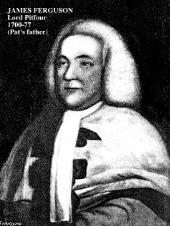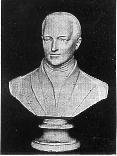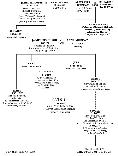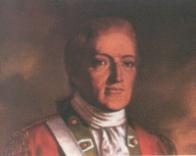See also
- Anne MURRAY's parents: Alexander MURRAY (1677-1735) and Elizabeth STIRLING (bef1683-1756)
- Anne MURRAY's siblings: Elizabeth MURRAY (1701-1748), Patrick MURRAY (1703-1778), Alexander MURRAY (1704-1705), George MURRAY (1706-1785), Gideon MURRAY (1710-1776), John MURRAY (1711-1711), Alexander MURRAY (1712-1778), Mary MURRAY (1714-1772), Helen MURRAY (1716-1809), James Patrick 1 MURRAY (1721-1794), Barbara MURRAY ( -1773) and Janet MURRAY (1723- )
Anne MURRAY (1708-1793)
1. Anne MURRAY, daughter of Alexander MURRAY 4th Lord Elibank (1677-1735) and Elizabeth STIRLING (bef1683-1756), was born on 20 September 1708. She married James FERGUSON on 3 February 1733 in Aberlady. She died on 2 January 1793.
From a letter to her brother, General Jon. James Murray:
"I have three girls, none of whom have any claims to the beauties of the body. Annie whom you visited in the Small Pox is of a low stature, and pretty much pitted without having her features altered by them. Betty is taller than I am, genteel enough and when in here good looks is thought by strangers to have a resemblance to my Sister Jannie; Jeanie who is of Annies size is in point of looks middling, but for a soul and genious I'll sett her loose with any she that ever stept in petticoats, she had cost me more trouble than all the rest, for her genious bewitched me, and some times got the better of my reason. But now, after Hunting, Riding, Shooting and Latin, I have got her brought to a moderate use of her needle, which with a little musick, bowling and chess, which I indulge her in, makes her turn out a good decent girl of sixteen. As to her dancing, its the Horn Pipe she excells in; but I must not conclude without assuring you that they are modest, virtuous girls, uncapable of lying of falsehood, and just the reverse of some others that you'll remember.".
James FERGUSON of Pitfour, son of James FERGUSON (1672-1734) and Anne STUART of Crichie (1669-1731), was born in 1700. He had the title '2nd of Pitfour'. He died on 25 June 1777 in Woolmet. He and Anne MURRAY had the following children:
| +2 | |
| +3 | |
| +4 | |
| +5 | |
| +6 | |
| +7 |
Second Generation
2. James FERGUSON, son of James FERGUSON of Pitfour and Anne MURRAY, was born in 1735. He had the title '3rd of Pitfour'. He was an Advocate, MP. He died in 1820.
He was unmarried and had no issue. He was MP for Banffshire (1789-90) and Aberdeenshire (1790-1820). He died as "Father of The House of Commons".
3. Annie FERGUSON was the daughter of James FERGUSON of Pitfour and Anne MURRAY.
She was unmarried and had no issue.
4. Betty FERGUSON, daughter of James FERGUSON of Pitfour and Anne MURRAY, died in 1810. She married Alexander SCRYMGEOUR.
5. Patrick FERGUSON, son of James FERGUSON of Pitfour and Anne MURRAY, was born in 1744 in Edinburgh. He died in 1777 in Pennsylvania.
Early Life: 1744-1777
Patrick Ferguson was born in Edinburgh, Scotland on June 4, 1744 to James Ferguson of Pitford. His father was a lawyer and had defended the followers of Bonnie Prince Charlie in 1745. In 1764, he had become Lord Pitford. Patrick's older brother was a friend of Pitt the Younger and served for thirty years in Parliament. His mother was sister to Major General James Murray, who had served under Major General James Wolfe in his Quebec campaign, even commanding the left wing at the Plains of Abraham.
On July 12, 1759, at the age of 15, Ferguson joined the Royal North British Dragoons, later known as the Scots Greys, as a cornet after having studied at a military academy in his youth. When he was 17, while serving in Germany, he contracted an illness that left him with a slightly lame leg. The illness troubled him from 1762 to 1768, keeping him out of military service. He spent most of that time at home, although in 1766, he spent some time in Paris. On September 1, 1768, he purchased a captaincy in the 70th Foot Regiment. He served with them putting down a slave rebellioin in Tobago in the West Indies where his younger brother, George was governor. Patrick contracted fever, and also being plagued by his illness, he returned to England in 1774.
Ferguson attended Light Infantry camp in Salisbury in the summer of 1775, where he first attracted the attention of Maj. General William Howe. In the year following, he worked on developing a breech-loading rifle. The Ferguson Rifle was a modification on the Chaumette rifle, which he demonstrated to King George III and then before the top brass of the British Army at Woolwich with excellent results. He even secured a patent on December 2, 1776, which has led to some controversy over whether he actually developed the rifle, or was merely the first to patent the improvements.
Revolutionary War: 1777-1778
Following Ferguson's impressive demonstration before King George III, he was given command of a 100-man experimental rifle company and sent to America in 1777. He and his company first saw action at the Battle of Brandywine, Pennsylvania on September 11, 1777. During the battle, he chose not to shoot a Continental officer, who may have been General George Washington, because it would have meant shooting him in the back. Later on that battlefield, Ferguson's right elbow was shattered by a rifle ball.
Ferguson spent the next eight months in Philadelphia undergoing surgeries in order to avoid amputation of the arm. In the meantime, he learned to use his left hand for writing, shooting and fencing. He never regained the use of his right arm. While he had been convalescing, General Howe disbanded his experimental ranger company and the rifles were put in storage. Following his recovery, Ferguson was used to gather intelligence and lead raids on privateer bases.
Little Egg Harbor, New Jersey: October 1778
On October 4-5, 1778, Captain Patrick Ferguson led 300 men from the 70th regiment and the 3rd New Jersey Tory Regiment against a privateer base at Little Egg Harbor. Meanwhile, a naval force also approached. Pulaski's Legion of Continentals was sent to combat the British, but Ferguson was able to destroy ten vessels and moved twenty miles up the Mullica River destroying storehouses, shipyards and homes of prominant patriots.
When Ferguson return to the mouth of the river, he learned that Pulaski was camped not far away and security was lax. Some believe that Captain Gustav Juliet had deserted Pulaski and gave the British that information. Ferguson took 250 men, rowed ten miles in small boat under the cover of darkness and surprised Pulaski at Mincock Island. At about 4 A.M. on October 5, 1778, the British Tories entered three house and killed about fifty officers and men by bayonet. Pulaski's infantry commander Colonel de Boze was killed in the attack. Pulaski arrived with his dragoons and was able to drive Ferguson back to his boats with some of his men captured in the confusion. The Americans raised charges of a massacre. There is some dispute over the dates of the attack with some listing it on October 15, 1778.
Revolutionary War: 1778-1779
Ferguson had now won the respect and confidence of General Howe's successor, Lt. General Henry Clinton. In 1779, Clinton named Ferguson Commandant of Stony Point where he oversaw the building of fortifications. But in October 1779, he was ordered to dismantle and withdraw. On October 26, 1779, Ferguson was promoted to Major in the 71st Highlanders and put in command of the American Volunteers, which were made up of New York and New Jersey Tory units. He then joined General Clinton and Lt. General Charles Cornwallis when they sailed south.
Southern Campaign: 1780
In February 1780 as part of the approach force, he was put ashore in South Carolina in command of 300 cavalry including 150 American Volunteers and 150 men detatched from the 71st Highlanders. During the march to Charleston, South Carolina, Ferguson's Rangers were accidentally attacked by Lt. Colonel Banastre Tarleton's British Legion and Ferguson's good left arm was bayoneted. He would fully recover, but spent some time riding with his reins in his teeth.
Captain Ferguson rejoined General Clinton on March 25, 1780 outside of Charleston. He was then detached to cut off American lines of communication. On April 13, he joined up with Lt. Colonel Tarleton and his British Legion in an operation to secure a supply depot at Monck's Corner, South Carolina. On the 14th, they intercepted a letter from Brig. General Isaac Huger to Maj. General Benjamin Lincoln, which revealed the Continental deployments around Monck's Corner. They were reinforced with infantry under Lt. Colonel James Webster and in the early morning hours of April 14, 1780, they totally surprised and routed General Huger. Ferguson then operated on the north bank of the Cooper River and participated in the capture of Fort Moultrie on May 7, 1780.
Southern Campaign: 1780
On May 22, 1780, Lt. General Henry Clinton appointed Major Ferguson Inspector of Militia in the Southern Provinces. He had the difficult task of raising militia units from the Loyalists of the Carolina Back Country. With the help of Major George Hanger, he raised 4,000 Loyalists from around Ninety-Six. On August 8, he and his men skirmished with Colonel Elijah Clarke and Colonel Isaac Shelby at Cedar Springs. On September 2, 1780, Lt. General Charles Cornwallis ordered Ferguson to move west into the mountains in order to protect his army's left flank as he invaded North Carolina.
On September 7, 1780, Ferguson set up his base of operations at Gilbert Town, North Carolina, but withdrew on the 10th when he moved back south in an effort to intercept Colonel Clarke who was leading a force against Augusta, Georgia. Before he had left on the 10th he had paroled Rebel Samuel Phillips with a message for the nearby Blue Ridge mountain communities telling them to "desist from their opposition to the British arms, and take protection under his standard" or "he would march his army over the mountains, hang their leaders, and lay their country waste with fire and sword."
This message enraged the Over Mountain men and the men of the nearby backcountry. These men had mostly sat out of the war, but with their own homes and families threatened, they came to action. On September 20, Ferguson returned to Gilbert Town. The Over Mountain Men gathered at Sycamore Shoals on September 25 and set out after Ferguson the next day. On September 27, Ferguson withdrew south, having learned of the force moving against him. On October 1, he turned east toward Charlotte, North Carolina where General Cornwallis was now located. He did not seem to be overly worried, because he was setting a slow pace, although he did send a letter asking for 300 or 400 reinforcements that "would finish this business."
But a week later, Major Ferguson learned from spies that the Over Mountain Men were closing in and he chose to make his stand at King's Mountain, South Carolina. He sent a letter to General Cornwallis on October 6, informing him of his decision. He chose the higher ground, fortifying the heel of the mountain. The Over Mountain Men arrived the following afternoon and divided into four columns, surrounding the mountain. They made relentless rushes up the mountain, while Ferguson could be heard rallying his men by blowing his Silver Whistle. Finally, when the Rebels were closing in, Ferguson tried to break through the lines and escape, but was felled by a multitude of rifle balls.
Bibliography:
1. http://www.silverwhistle.co.uk/lobsters/ferguson.html
2. Boatner, Michael; Encyclopedia of the American Revolution
3. Buchanan, John; The Road to Guilford Courthouse
4. Morrill, Dr. Dan; Southern Campaigns of the American Revolution.
Patrick Ferguson was born on 24 May/4 June 1744. He was the second son of James Ferguson of Pitfour, an Aberdeenshire-born advocate, and his wife Anne Murray, sister of the noted literary patron, Patrick, Lord Elibank. The Fergusons lived mostly in and around Edinburgh — then "a hotbed of genius" according to their acquaintance, the novelist Tobias Smollett — and mixed with the leading figures in the Scottish Enlightenment. Other friends included John Home, David Hume, Adam Ferguson (no relation), Allan Ramsay, & c. Between 1764-76, James Ferguson served on the bench as 'Lord Pitfour', and as a judge was noted for clemency and wit. The Fergusons were a cultured and affectionate family. The three boys and three girls who reached adulthood all had lively and distinctive personalities. The eldest son, Jamie, was MP for Aberdeenshire for 30 years, dying as 'Father of the House of Commons' in 1820, aged 85, while the youngest, George, was, for a time, Lieutenant-Governor of Tobago.
"Pattie," as his family called him, was extremely slender — he often joked about being nothing but bone — and not very tall. But his features were handsome, slightly elfin-looking. His personal letters reveal him as a gentle yet fun-loving young man, with great wit and charm. He was intelligent, sensitive, honourable, and remarkably courageous; flirtatious, too, when he had time! An articulate and expressive writer, it is a singular tragedy that he did not live to write his memoirs.
Ferguson began his career, aged 15, as Cornet in the Royal North British Dragoons (Scots Greys), encouraged by his uncle Gen. James Murray. After training, he was sent to Germany in 1761, where he served in the Seven Years' War, until illness left him with a lame leg, which gave him years of intermittent trouble. He then served with his regiment on garrison duty around Britain. He visited France twice in 1766. In 1768, he bought a Captaincy in the 70th Foot, and spent 3 years in the Caribbean. He returned to Britain in 1772.
A brilliant marksman with innovative ideas on light infantry tactics, he improved Chaumette's breechloading mechanism, already used in sporting guns, for use in a military rifle. The Ferguson Rifle was successfully tested, at his own expense, in 1776. With such a weapon, light infantry troops would be able to continue loading and firing without breaking cover or while lying prone. Appointed Captain Commandant of his own corps, armed with Ferguson rifles, he was sent to North America in spring 1777.
The green-clad rifle company served in New Jersey, before sailing to the Chesapeake in August 1777 to take part in Howe's campaign to capture Philadelphia. They performed well, and Howe, impressed, assured Ferguson that the little corps of 100 men would be increased — but tragedy intervened.
In their only major engagement at Brandywine on 11 September 1777, Ferguson had the chance to shoot a senior-looking Rebel officer, who was riding out with a French hussar as escort, but, as he later wrote, the idea of shooting in the back someone who was going about his duties so coolly, and did not pose a threat, "disgusted" him. Even when told next day that the officer in question was Washington, he did not regret his chivalry. 54 years later, Fenimore Cooper claimed his father-in-law, De Lancey, then serving with Ferguson, had said the officer involved was Pulaski, not Washington, and that the incident happened after Ferguson was maimed, not before — but this is contradicted, nearer the time, by Ferguson himself, and by the extent of his injuries. It is possible that Pulaski may have been the French hussar.
It was moments after sparing these horsemen that Ferguson was gravely wounded — shot through the right elbow-joint. For 8 months, in Philadelphia, he suffered numerous agonising operations to remove bone splinters, under threat of amputation — or death. In letters home, dictated or written left-handed, he joked bravely about his plight and made wisecracks about the surgeons who argued whether his arm should belong to him or "the worms". He kept his arm, but it was permanently crippled. The plans for augmenting his rifle company had to be curtailed. The army gave higher priority to making more of the less expensive, general service weapons, and the corps was disbanded. There is no need to advance any conspiracy theories about this: the corps had been an experiment, and at the time it seemed unlikely that Ferguson would ever be fit for service again. However, he was tougher than he looked. Undeterred, he learned to fence and shoot with his left hand.
By autumn 1778, Ferguson, nicknamed "The Bulldog" for his tenacity, was leading daring raids, such as that against the privateer base, Little Egg Harbor, in NJ. As commander of Stony Point in 1779, he designed improvements to the fortifications. He also wrote proposals to curtail marauding against civilians. He was commissioned Major in the 71st Regt. (Fraser's Highlanders), and at the turn of 1779-80, was posted South in the campaign for the Carolinas.
In March 1780, at MacPherson's Plantation, near Charleston, Ferguson was bayoneted through his good arm in a 'friendly fire' incident involving Charles Cochrane and the British Legion infantry. For 3 weeks he rode with the reins in his mouth, propped up in the saddle by his orderlies. With the capture of Charleston, Gen. Sir Henry Clinton appointed him Inspector of Militia, to recruit and train local Loyalists. He gave up a brevet Lieutenant Colonelcy to do so. Recognising that the war in the South was a civil war, he tried to win people over to the Loyalist cause, visiting their houses and talking to them.
In autumn 1780, Ferguson warned the 'Overmountain' men to desist from rebellion or he would bring fire and sword down upon them, and hang their leaders. The Rebels took up the challenge: to hunt down Ferguson. There was no question of taking him alive. The counter-sign was "Buford" — in revenge for the losses at Waxhaws.
When Ferguson learned of the enemy's advance, he issued an impassioned proclamation to rally the local Loyalists, and began to withdraw towards Cornwallis' base in Charlotte. On 6 October, he encamped on King's Mountain, expecting reinforcements — but some messages were intercepted, and those which reached Cornwallis were not dealt with immediately, because of illness.
On 7 October 1780, the Loyalists made their stand when the Rebels surrounded them in a surprise attack. In a desperate struggle, Patrick Ferguson, the only British serviceman in the battle, fought heroically, until he was shot from his horse. His slight body, which had overcome so much pain and disability, was torn by at least 8 bullets. He died within minutes, without regaining consciousness. Rebel fire continued for some time after the white flag was raised. The subsequent abuse of the prisoners, several of whom were hanged and others hacked at with swords on the march up country, brought the Rebels no glory. Ferguson's corpse was brutally treated, and buried under a cairn on the hillside. Legend has it that his girlfriend, Virginia Sal, shot early in the battle, shares his grave.
Reinforcements arrived 3 days too late, and news of their "gentle Pattie"'s death reached his widowed mother and siblings in Scotland shortly before Christmas, 1780.
– Dr. M. M. Gilchrist, St. Andrews, Scotland, 1999.
6. Jeanie FERGUSON, daughter of James FERGUSON of Pitfour and Anne MURRAY, was born in 1746. She died in 1821.
7. George FERGUSON, son of James FERGUSON of Pitfour and Anne MURRAY, was born in 1748. He had the title 'Fourth of Pitfour'. He died in 1820.
He was at one time Governor of Tobago in the West Indies. He was unmarried and had "illegitimate issue".
George FERGUSON had the following children:
| +8 |
Third Generation
8. Vice-Admiral George FERGUSON RN, son of George FERGUSON, was a Vice-Admiral in the Navy. He had the title '5th of Pitfour'. He died in 1867. He married Elizabeth Holcombe WOODHOUSE. He married Elizabeth Jane ROWLEY.
He was MP for Banffshire from 1833. He had one daughter with his first wife. All subsequent Fergusons of Pitfour are descended from him.
Elizabeth Jane ROWLEY was the daughter of CLOTWORTHY ( - ).



